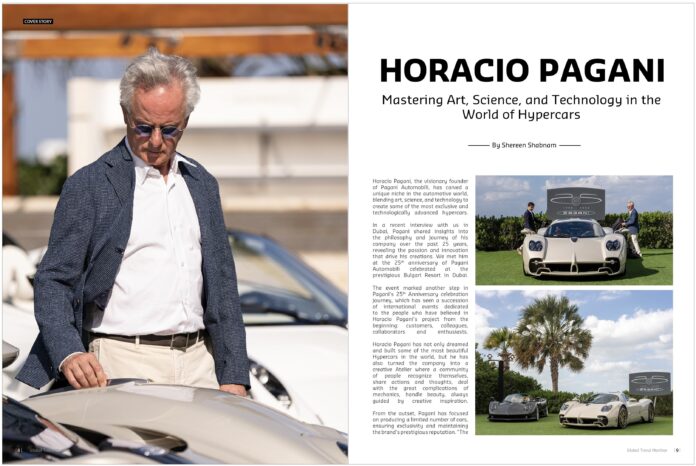Shereen Shabnam
Horacio Pagani, the visionary founder of Pagani Automobili, has carved a unique niche in the automotive world, blending art, science, and technology to create some of the most exclusive and technologically advanced hypercars.
In a recent interview with us in Dubai, Pagani shared insights into the philosophy and journey of his company over the past 25 years, revealing the passion and innovation that drive his creations. We met him at the 25th anniversary of Pagani Automobili celebrated at the prestigious Bulgari Resort in Dubai.
The event marked another step in Pagani’s 25th Anniversary celebration journey, which has seen a succession of international events dedicated to the people who have believed in Horacio Pagani’s project from the beginning: customers, colleagues, collaborators and enthusiasts.
Horacio Pagani has not only dreamed and built some of the most beautiful Hypercars in the world, but he has also turned the company into a creative Atelier where a community of people recognize themselves, share actions and thoughts, deal with the great complications of mechanics, handle beauty, always guided by creative inspiration.
From the outset, Pagani has focused on producing a limited number of cars, ensuring exclusivity and maintaining the brand’s prestigious reputation. “The cars were always a concentration of technology,” Pagani explains, highlighting the importance of innovation in his designs. This commitment to technological advancement, coupled with the brand’s exclusivity, has been a key factor in Pagani’s success.
Pagani credits the company’s economic self-sufficiency to its management by a close-knit team, including family members and a small group of managers raised within the factory. This structure has allowed Pagani to invest in research and development, furthering technological progress and ensuring the company remains at the forefront of the automotive industry.
Pagani believes that his cars should evoke emotions, transcending their practical utility. He draws inspiration from Leonardo da Vinci’s Renaissance principle that art and science can walk hand in hand. Modern tools and data-driven studies enable Pagani’s engineers and designers to create cars where aesthetics and technology are seamlessly integrated, resulting in vehicles that are not only beautiful but also scientifically advanced.
During the interview we spoke extensively about Utopia. Utopia marks the beginning of the third chapter in the brand’s history, making its debut in the Middle East and Africa region. The new Hypercar features a simple and timeless design that embodies a visionary and counter-trend automotive concept.
Drawing inspiration from the purest Leonardo da Vinci principle of Art and Science, the aim is to create an object that seamlessly combines refined aesthetic appeal with cutting-edge technology. With only 99 specimens produced, the first series of Utopia Coupé has already been allocated to a select circle of enthusiasts.
Before we started the interview, we were also able to view the Zonda F Roadster, with new triaxial carbon fiber fabric. The chassis has been redesigned and the weight of the coupé has been kept the same (1,230 kg). The result is a highly efficient aerodynamic car that set a time of 7’29 on the Nürburgring track.
Produced only in the Clubsport version, since this set-up turned out to be far more popular than the original, thanks also to the engine’s increased power output to 650 HP, the Roadster F features a Brembo braking system, with 38 cm diameter carbon-ceramic self-ventilating discs, both front and rear and aluminum and magnesium alloy wheels, designed by Pagani and made by APP-Tech, 19 inches high in front and 20 inches in the rear.
Next to the Zonda F Roadster, we came across the Huayra Roadster. Described by Horacio Pagani as the «most complicated project», it is a car almost entirely on view, with every component, every mechanical part proudly displayed. It is the first-ever Roadster to be lighter than the Coupé version.
Such a goal was achieved thanks to the complete overhaul of all components and the development of new advanced composite formulas, including Carbo-Triax HP52 combined with Carbo-Titanium which allowed the team to reduce the car’s weight by 80 kg compared to the previous coupé and achieve a 52% increase in rigidity. It took six years of hard work to fully develop it, paying attention to every detail. The final result is an open-top car produced in 100 units according to the most authentic Pagani philosophy.
Pagani’s influence extends beyond hypercars, as the company has ventured into designing interiors for helicopters and jets, applying the same principles of art, science, and technology. The focus is on using lightweight materials like carbon fiber and titanium, which are staples in Pagani’s cars, to enhance the performance and efficiency of aircraft.
Horacio Pagani’s journey with Pagani Automobili is a testament to his relentless pursuit of combining art, science, and technology in the automotive world. As Pagani continues to push the boundaries of innovation and design, the brand’s legacy as a creator of emotion-evoking, technologically advanced hypercars is set to endure for years to come.
